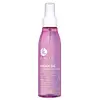What's inside
What's inside
 Key Ingredients
Key Ingredients

No key ingredients
 Benefits
Benefits

 Concerns
Concerns

 Ingredients Side-by-side
Ingredients Side-by-side

Water
Skin ConditioningPropylene Glycol
HumectantPEG-12 Dimethicone
Skin ConditioningGlycerin
HumectantPEG-40 Hydrogenated Castor Oil
EmulsifyingPhenoxyethanol
PreservativeParfum
MaskingDisodium EDTA
DMDM Hydantoin
PreservativeTrideceth-5
EmulsifyingArgania Spinosa Kernel Oil
EmollientHelianthus Annuus Seed Oil
EmollientTocopheryl Acetate
AntioxidantCocodimonium Hydroxypropyl Hydrolyzed Keratin
Skin ConditioningHydrolyzed Wheat Protein
Skin ConditioningHydrolyzed Corn Protein
Skin ConditioningHydrolyzed Soy Protein
HumectantAmodimethicone
Ethylhexyl Salicylate
UV AbsorberWater, Propylene Glycol, PEG-12 Dimethicone, Glycerin, PEG-40 Hydrogenated Castor Oil, Phenoxyethanol, Parfum, Disodium EDTA, DMDM Hydantoin, Trideceth-5, Argania Spinosa Kernel Oil, Helianthus Annuus Seed Oil, Tocopheryl Acetate, Cocodimonium Hydroxypropyl Hydrolyzed Keratin, Hydrolyzed Wheat Protein, Hydrolyzed Corn Protein, Hydrolyzed Soy Protein, Amodimethicone, Ethylhexyl Salicylate
Crambe Abyssinica Seed Oil Phytosterol Esters
EmulsifyingHydrogenated Ethylhexyl Olivate
EmollientSaccharomyces Cerevisiae Extract
Skin ConditioningGlycerin
HumectantSqualane
EmollientHydrogenated Olive Oil Unsaponifiables
EmollientBrassica Oleracea Acephala Leaf Extract
HumectantCucurbita Pepo Seed Extract
Skin ConditioningLentinus Edodes Extract
Skin ConditioningOpuntia Tuna Fruit Extract
Skin ConditioningPsidium Guajava Fruit Extract
AstringentRibes Nigrum Fruit Extract
AstringentC20-22 Alkyl Phosphate
EmulsifyingC20-22 Alcohols
Emulsion StabilisingPolysorbate 60
EmulsifyingPolyester-11
Skin ConditioningHydroxyethyl Acrylate/Sodium Acryloyldimethyl Taurate Copolymer
Emulsion StabilisingEthylhexylglycerin
Skin ConditioningCitric Acid
BufferingDisodium EDTA
Leuconostoc/Radish Root Ferment Filtrate
AntimicrobialPotassium Sorbate
PreservativeAminomethyl Propanol
BufferingSodium Hydroxide
BufferingPhenoxyethanol
PreservativeSodium Benzoate
MaskingParfum
MaskingLinalool
PerfumingLimonene
PerfumingGeraniol
PerfumingCrambe Abyssinica Seed Oil Phytosterol Esters, Hydrogenated Ethylhexyl Olivate, Saccharomyces Cerevisiae Extract, Glycerin, Squalane, Hydrogenated Olive Oil Unsaponifiables, Brassica Oleracea Acephala Leaf Extract, Cucurbita Pepo Seed Extract, Lentinus Edodes Extract, Opuntia Tuna Fruit Extract, Psidium Guajava Fruit Extract, Ribes Nigrum Fruit Extract, C20-22 Alkyl Phosphate, C20-22 Alcohols, Polysorbate 60, Polyester-11, Hydroxyethyl Acrylate/Sodium Acryloyldimethyl Taurate Copolymer, Ethylhexylglycerin, Citric Acid, Disodium EDTA, Leuconostoc/Radish Root Ferment Filtrate, Potassium Sorbate, Aminomethyl Propanol, Sodium Hydroxide, Phenoxyethanol, Sodium Benzoate, Parfum, Linalool, Limonene, Geraniol
Ingredients Explained
These ingredients are found in both products.
Ingredients higher up in an ingredient list are typically present in a larger amount.
Disodium EDTA plays a role in making products more stable by aiding other preservatives.
It is a chelating agent, meaning it neutralizes metal ions that may be found in a product.
Disodium EDTA is a salt of edetic acid and is found to be safe in cosmetic ingredients.
Learn more about Disodium EDTAGlycerin is already naturally found in your skin. It helps moisturize and protect your skin.
A study from 2016 found glycerin to be more effective as a humectant than AHAs and hyaluronic acid.
As a humectant, it helps the skin stay hydrated by pulling moisture to your skin. The low molecular weight of glycerin allows it to pull moisture into the deeper layers of your skin.
Hydrated skin improves your skin barrier; Your skin barrier helps protect against irritants and bacteria.
Glycerin has also been found to have antimicrobial and antiviral properties. Due to these properties, glycerin is often used in wound and burn treatments.
In cosmetics, glycerin is usually derived from plants such as soybean or palm. However, it can also be sourced from animals, such as tallow or animal fat.
This ingredient is organic, colorless, odorless, and non-toxic.
Glycerin is the name for this ingredient in American English. British English uses Glycerol/Glycerine.
Learn more about GlycerinParfum is a catch-all term for an ingredient or more that is used to give a scent to products.
Also called "fragrance", this ingredient can be a blend of hundreds of chemicals or plant oils. This means every product with "fragrance" or "parfum" in the ingredients list is a different mixture.
For instance, Habanolide is a proprietary trade name for a specific aroma chemical. When used as a fragrance ingredient in cosmetics, most aroma chemicals fall under the broad labeling category of “FRAGRANCE” or “PARFUM” according to EU and US regulations.
The term 'parfum' or 'fragrance' is not regulated in many countries. In many cases, it is up to the brand to define this term.
For instance, many brands choose to label themselves as "fragrance-free" because they are not using synthetic fragrances. However, their products may still contain ingredients such as essential oils that are considered a fragrance by INCI standards.
One example is Calendula flower extract. Calendula is an essential oil that still imparts a scent or 'fragrance'.
Depending on the blend, the ingredients in the mixture can cause allergies and sensitivities on the skin. Some ingredients that are known EU allergens include linalool and citronellol.
Parfum can also be used to mask or cover an unpleasant scent.
The bottom line is: not all fragrances/parfum/ingredients are created equally. If you are worried about fragrances, we recommend taking a closer look at an ingredient. And of course, we always recommend speaking with a professional.
Learn more about ParfumPhenoxyethanol is a preservative that has germicide, antimicrobial, and aromatic properties. Studies show that phenoxyethanol can prevent microbial growth. By itself, it has a scent that is similar to that of a rose.
It's often used in formulations along with Caprylyl Glycol to preserve the shelf life of products.